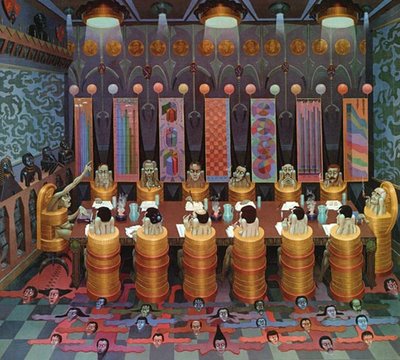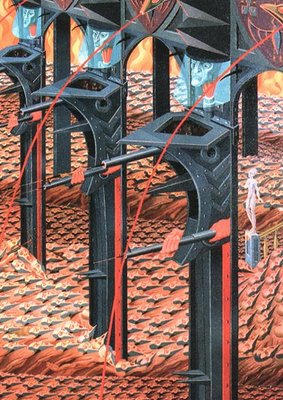Social Surrealist: Irving Norman Part 2

Meeting of the Elders 3 © Irving Norman 1977 (Click on image for larger view). All images in this series are presented with Hela Norman's permission.
Yesterday I went back to Sacramento to see the Irving Norman exhibit at the Crocker Museum again. Each time I see Norman's monumental paintings (most of which are larger than ten feet square), I'm awestruck by his technical abilities as a draftsman and painter. The detail in his artwork is simply astonishing and as an artist who's always struggled with realism, I find his work magical.
I was also struck by the timelessness of Norman's subject matter. He focused on the human condition, particularly the human body and how it's manipulated by environment and physical space. He also didn’t shy away from bold "liberal" even socialist political statements. I greatly admire his courage in that respect. Although it kept him from getting his proper due from the art world (to this day in fact), Norman knew that broadcasting the messages he was spreading was vastly more important than personal aggrandizement. He seemed to strive for nothing less than to save humanity from itself.

Liberation War Prisoners © Irving Norman 1970-71 (Click on image for larger view). All images in this series are presented with Hela Norman's permission.
Most of his work deals with urban living, industrialization, economic inequality, and war. Sometimes more than one of these issues is covered in a single painting, no doubt because they overlap in reality. Over a span of 35 years, he painted about these themes. What's remarkable, and terribly upsetting, is noting how little progress we've made regarding these basic issues in the past half century. America is today embroiled in perhaps the most senseless war of all time. It appears we've learned nothing from the terrible mistakes of Vietnam and previous violent attempts to push other groups of people around.
Norman's commentary about the horrors and abuses of war, coupled with the financial benefits certain elites gain from it, are as relevant today as they were when he put them to canvas. Indeed it is painful to look at this bare truth straight on but it is also necessary. We'll keep smashing our heads against the same stone walls of power until we learn there are actually ways around the walls. Being too fearful or lazy to look for alternatives to war is no excuse for abdicating our responsibilities to future generations of human beings.

Rebellions and Revolution © Irving Norman 1970 (Click on image for larger view). All images in this series are presented with Hela Norman's permission.
If "War is not the Answer" then we ourselves, the regular people of the world, must find another answer. It's obvious our "leaders" and the powerful think war works just fine thanksverymuch. Chevron and Bechtel corporations will never willingly give up their investments in war, so they must be forced to do so by us, their customers. The alternative, as we have seen in the tragic case of Iraq, is endless, destructive, inhumane war. We cannot allow that.

Rebellions and Revolutions (Detail) © Irving Norman 1970 (Click on image for larger view). All images in this series are presented with Hela Norman's permission.
See Irving Norman's paintings and drawings live and in person on exhibit now in Sacramento, CA. This rare opportunity to see some of the painter's best works, at The Crocker Museum ends January 7, 2007.
Note: If you're unable to see Norman's work in person you may want to purchase a copy of the book, Dark Metropolis. It's well written and has large, clear, vivid reproductions of Norman's art.
Please respect the work of the artists you see here and be sure to credit them when you share their artwork with others.
To share your opinion on this or any other post, please click the word "COMMENTS" below.




0 Comments:
Post a Comment
<< Home